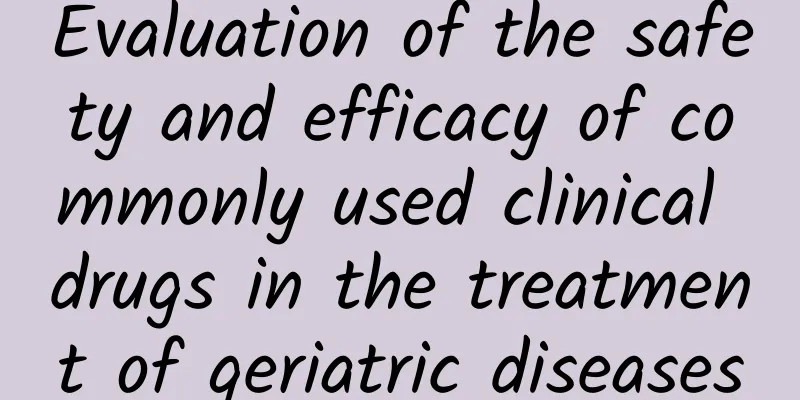Evaluation of the safety and efficacy of commonly used clinical drugs in the treatment of geriatric diseases

|
With the increasing trend of population aging, the prevention and treatment of geriatric diseases has become an important issue in the field of medical and health care. In the treatment of geriatric diseases, drug therapy is a common treatment method, and its safety and effectiveness are crucial to ensuring the health of the elderly. However, due to the decline of physical functions and the coexistence of multiple chronic diseases, the safety and effectiveness of drugs in the elderly population has become particularly complicated. This article aims to review the safety and effectiveness of commonly used clinical drugs in the treatment of geriatric diseases, in order to provide a reference for drug treatment of geriatric diseases. 1. The particularity of geriatric diseases and the challenges of drug treatment Geriatric diseases are characterized by long course, complex condition, and coexistence of multiple systems, which brings many challenges to drug treatment. First, the decline in the body functions of the elderly leads to a decrease in the ability to metabolize and excrete drugs, which changes the concentration and duration of action of drugs in the body, thereby increasing the risk of adverse drug reactions [1,2]. Secondly, the elderly may suffer from multiple chronic diseases at the same time and need to take medication for a long time, which increases the risk of drug interactions and repeated use of drugs. In addition, the tolerance and sensitivity of the elderly to drugs may also change, making the evaluation of drug efficacy more difficult. 2. Safety evaluation of commonly used clinical drugs in the treatment of geriatric diseases In the treatment of geriatric diseases, drug safety evaluation is a crucial part. With the increase of age, the physiological and pathological characteristics of the elderly have changed significantly, and these changes make the safety issues of drugs in the elderly population more complex and diverse. Therefore, in the treatment of geriatric diseases, we need to pay special attention to the safety of drugs to ensure that elderly patients can use drugs safely. First, cardiovascular drugs are one of the most commonly used drugs in the elderly population. However, the safety of cardiovascular drugs in the elderly population cannot be ignored. Due to the decline in the function of the cardiovascular system, the elderly are prone to adverse reactions such as hypotension and bradycardia. For example, while some antihypertensive drugs can lower blood pressure, they may cause the blood pressure of elderly patients to be too low, causing symptoms such as dizziness and fatigue; while some antiarrhythmic drugs may cause the heart rate of elderly patients to be too slow, resulting in insufficient blood supply to the heart. Therefore, when using cardiovascular drugs, doctors should make individual adjustments based on the specific conditions of elderly patients and select the appropriate type and dosage of drugs to ensure the safe use of drugs [3]. Secondly, hypoglycemic drugs are also one of the commonly used drugs in the elderly population. However, the elderly are prone to serious complications such as hypoglycemia when using hypoglycemic drugs. This is because the insulin secretion function of the elderly is reduced, the sensitivity to drugs is increased, and hypoglycemia reactions are prone to occur. Hypoglycemia not only causes discomfort in elderly patients, but may also lead to serious consequences such as coma and convulsions. Therefore, when using hypoglycemic drugs, doctors should pay special attention to the blood sugar changes of elderly patients, adjust the drug dosage in time, and avoid the occurrence of hypoglycemia. In addition, the use of anti-osteoporosis drugs in the elderly population is becoming increasingly common. However, while these drugs increase bone density, they may also bring certain risks. For example, some anti-osteoporosis drugs may increase the risk of fractures, especially in elderly patients. This is because these drugs may inhibit the bone resorption process and make bones more fragile. Therefore, when using anti-osteoporosis drugs, doctors should weigh the pros and cons and make choices based on the specific circumstances of elderly patients to avoid unnecessary risks. In order to ensure the safe use of drugs in the elderly population, we need to establish a sound adverse drug event monitoring and reporting system. By regularly collecting and analyzing data on adverse drug events, we can promptly detect and deal with adverse drug reactions and reduce drug risks. At the same time, doctors should also strengthen medication guidance for elderly patients, inform them of possible adverse reactions and precautions, and improve their awareness of medication safety. 3. Evaluation of the effectiveness of commonly used clinical drugs in the treatment of geriatric diseases In the treatment of geriatric diseases, the effectiveness evaluation of drugs is not only a direct measure of drug efficacy, but also a comprehensive consideration of the overall health status and improvement in the quality of life of elderly patients. Due to the particularity of the elderly population, they often suffer from multiple chronic diseases at the same time, and the effect of drug treatment requires comprehensive consideration of multiple factors. First, when evaluating the efficacy of a drug, we should not only focus on the degree of improvement of a specific symptom or indicator, but also on the impact of the drug on the overall health of elderly patients. For example, in the treatment of cardiovascular diseases, we should not only focus on whether antihypertensive drugs effectively lower blood pressure, but also whether they improve the patient's cardiac function and reduce the incidence of cardiovascular events. Similarly, in the treatment of diabetes, we should not only focus on whether hypoglycemic drugs effectively control blood sugar, but also whether they reduce the occurrence of diabetes complications and improve the quality of life of patients. Secondly, the improvement of the quality of life of elderly patients is one of the important criteria for evaluating the efficacy of drugs. The quality of life of elderly patients is often seriously impaired due to the influence of chronic diseases. Therefore, when selecting and using drugs, we should fully consider the impact of drugs on the quality of life of patients. For example, in pain treatment, we should not only pay attention to the analgesic effect of analgesics, but also pay attention to whether they improve the patient's sleep, diet and other quality of life indicators. In order to improve the effectiveness of drugs in the treatment of geriatric diseases, we can take the following measures: On the one hand, according to the specific condition and drug metabolism characteristics of the elderly, choose the appropriate drug type and dose. The drug metabolism capacity of the elderly decreases, and the concentration and duration of action of the drug in the body may change. Therefore, when selecting drugs, we need to fully consider the drug metabolism characteristics of the elderly, choose the appropriate drug type and dose, and ensure the safety and effectiveness of the drug in the elderly population. On the other hand, strengthen health education and self-management ability. Elderly patients often lack sufficient health knowledge and self-management ability, resulting in improper use of drugs or poor efficacy. Therefore, we need to strengthen health education and self-management ability training, so that elderly patients can use drugs correctly and follow doctor's advice, and improve the sustainability of drug efficacy. Finally, pay attention to regular follow-up and evaluation, and adjust the treatment plan in time. The conditions of elderly patients are often complex and changeable, and regular follow-up and evaluation are needed to understand the changes in the condition and the efficacy of the drugs. Through regular follow-up and evaluation, we can promptly detect and deal with adverse drug reactions, adjust the treatment plan, and ensure the continuity and stability of the drug efficacy. 5. Maintenance, rehabilitation and convalescence of drug treatment in the treatment of geriatric diseases In the treatment of geriatric diseases, drug therapy is only part of it. In addition to drug therapy, maintenance, rehabilitation and convalescence are also indispensable parts of the treatment of geriatric diseases. Provide elderly patients with a comfortable living environment, including a proper diet, good sleep, proper exercise, etc. At the same time, strengthen health education for the elderly and improve their health literacy and self-care ability. Develop personalized rehabilitation plans based on the specific conditions of elderly patients. Improve the physical functions and self-care abilities of elderly patients through physical therapy, sports training and other methods. Provide elderly patients with psychological support and opportunities for social interaction. Help elderly patients solve psychological problems and enhance their mental health through psychological counseling and psychological counseling. At the same time, organize cultural and entertainment activities, social activities, etc. to promote social interaction and mental health of elderly patients. VI. Conclusion In summary, the safety and effectiveness evaluation of commonly used clinical drugs in the treatment of geriatric diseases is an important guarantee for ensuring the health of the elderly. In the treatment of geriatric diseases, the special physiological and pathological characteristics of the elderly should be fully considered, appropriate drug types and dosages should be selected, and health education and self-management ability should be strengthened. At the same time, a variety of means such as maintenance, rehabilitation and convalescence should be combined to improve the treatment effect and quality of life of geriatric diseases. In the future, with the continuous development of medical technology and the deepening of the understanding of geriatric diseases, I believe that we will be able to better provide safe and effective drug treatment services for the elderly. References: [1] Wen Hao, Wang Shixiu, Lü Jing, et al. Research progress on safe medication management for elderly patients with chronic diseases during hospital-home transition period[J]. Journal of Nursing, 2023, 38(19): 117-121. [2] Zheng Meihua, Zheng Binbin. Research progress on the efficacy and safety of atorvastatin in primary and secondary prevention of coronary heart disease in elderly patients[J]. Capital Food and Medicine, 2023, 30(16): 18-21. [3] Chen Liyuan, He Qing. Research progress in drug treatment of elderly heart failure[J]. Chinese Journal of Health Care Medicine, 2021, 23(3): 315-318. The author of this article is Sun Qian, from the Second Retired Cadres Rest Home in Jinan, Shandong Military Region; |
>>: Summary of Common Problems of Multifocal Soft Lenses for Myopia Prevention and Control
Recommend
How thick is the endometrium that requires curettage?
When talking about the uterus, many friends will ...
Why does the vaginal discharge have blood streaks after abortion?
Many people have undergone abortions due to unexp...
What to do if you vomit during early pregnancy
It is normal for pregnant women to vomit when the...
Men should use it with caution! This weight loss drug can significantly increase the risk of ED
No dieting, no exercise, just a small pill, you c...
How to treat vaginal wetness
The human vagina will secrete certain substances,...
What foods are good for women's kidneys?
Nowadays, many people often feel dizzy, have head...
What kind of flour is used to make snail rice noodle? What does snail rice noodle taste like?
Some people think that snail noodles are fragrant...
What are the dangers of low albumin in late pregnancy?
When pregnant women reach the late stage of pregn...
The dangers of pelvic anterior tilt are actually these!
Pelvic tilt is a relatively common pathological p...
What should I do if my lower abdomen hurts on the right side during menstruation?
During the menstrual period every month, female f...
Insomnia, chest tightness, shortness of breath after hysterectomy
Life is always more malicious to women, and women...
Symptoms of vulvar vestibulitis
Many people are not particularly familiar with vu...
Unhappy pain: four unexpected reasons that force women to stop having sex
1Unreasonable bleeding Unless it's her first ...
What is the cause of stomach bloating when you are pregnant?
I believe everyone wants a healthy and beautiful ...
Can I have a normal birth if I have anemia in late pregnancy?
Pregnant women need to pay special attention to t...









